Something's Fishy: A year underwater
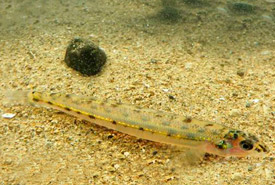
Eastern sand darter, Grand River, ON (Photo by Alan Dextrase/Ontario Ministry of Natural Resources and Forestry) © Queen's Printer for Ontario, 2016
For someone who writes about fish, it is no surprise that when I tell people what I do, it is always prompted by an inquiry about which finned species is my favourite.
That’s like asking a mother which of her children she likes best.
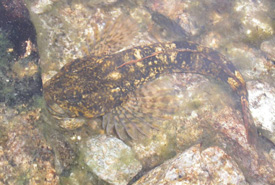
Mottled sculpin (Photo from Wikimedia Commons)
Each species of fish has a unique story; whether it is a tale of persevering, finding its way through new waters or learning to adapt to the effects of climate change. Over the past year, I’ve had the honour of telling these stories and sharing with Land Lines readers the many wonders that swim in waters across Canada.
The series started with sculpin, a species near and dear to my heart. I can still remember looking down at the fish and naively thinking that the fish I and the crew from the Central Lake of Ontario Conservation Authority (CLOCA) had caught was a fish-frog hybrid. Sculpins are characterized by their flat heads with giant cheeks protruding from either side, resembling a frog. Sixty-three species of sculpin reside in Canada, including the new friend I made that day: mottled sculpin.
Although not necessarily the most attractive species, this unique little fella is one of the reasons I fell in love with freshwater fish. But sometimes the stories I get to tell aren’t always as sweet as a Nicholas Sparks novel.
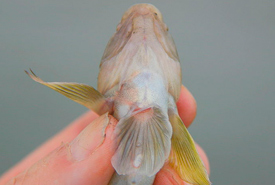
Two fused pelvic fins create a suction cup on the belly of round goby (Photo by Peter van der Sluijs/Wikimedia Commons)
Take, for instance, freshwater’s notorious round goby: it’s a species responsible for wiping out a significant amount of smaller fish species, in particular, mottled sculpin, for which it often is mistaken. Unlike sculpin, the body of this invasive species is completely scaled and can be identified by a black spot on its dorsal fin and a fused, scallop-shaped pelvic fin.
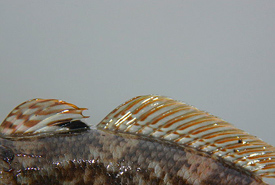
The dorsal fins of a round goby (Photo by Peter van der Sluijs/Wikimedia Commons)
This aggressive, rapidly reproducing fish is known to out-compete native species with similar niches. It is a threat to at-risk species in Ontario, such as northern madtom. The Ontario provincial government has combatted the spread of the species by prohibiting the domestic possession of live round goby and the use of the species as baitfish.
With waters full of invasive species, it’s tough out there for a native freshwater fish. But through hardship there are tales of species that are holding on by the skin of their fins, prevailing despite the many challenges they may face.
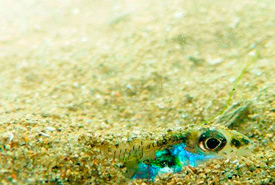
Eastern sand darter buried in the sandy bottom of Grand River, ON (Photo by Alan Dextrase/Ontario Ministry of Natural Resources and Forestry © Queen's Printer for Ontario, 2016)
Like, for instance, the story I shared about the eastern sand darter: a species that is still swimming strong, despite being endangered in Ontario. In 2008, three eastern sand darters were found in Big Creek, a watershed near Norfolk, Ontario, after a 50-year absence. Like molted sculpin, one of the biggest threats to this species’ population is round goby, but it is more greatly affected by siltation. Siltation occurs when too much soil mixes into a watershed and creates muddy waters, limiting oxygen flow and suffocating eastern sand darters’ eggs.
In Ontario, recovery strategies are being implemented to help rehabilitate eastern sand dater populations. The species is protected under the province’s Endangered Species Act and the federal Species at Risk Act, meaning it is illegal to catch and/or harm this species in any way.
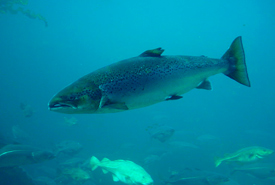
Atlantic salmon are an anadromous species, migrating from salt water to fresh water to spawn. (Photo by Hans-Petter Fjeld)
Conserving lands helps to ensure species have safe places to live. Although there are no eastern sand darters on any current Nature Conservancy of Canada properties, a threatened and endangered fish species resides on properties across Canada.
From learning about ancient species to migratory fish patterns, it’s safe to say that after a year of writing “Something’s Fishy,” I have accumulated a lake-full of freshwater fish knowledge.
Whether it is the effects of an invasive fish or a mighty comeback legend of an endangered species, every fish has its tale. There are many more stories left to be told until I find my favourite species, but until then my go-to follow up question to anyone who asks is: What’s your favourite?
Something’s Fishy is a monthly series written by NCC’s Editorial Coordinator, Raechel Bonomo, highlighting a species or group of fishes that inhabitant Canadian waters.


